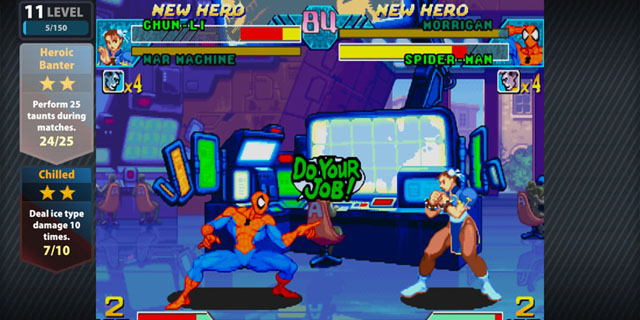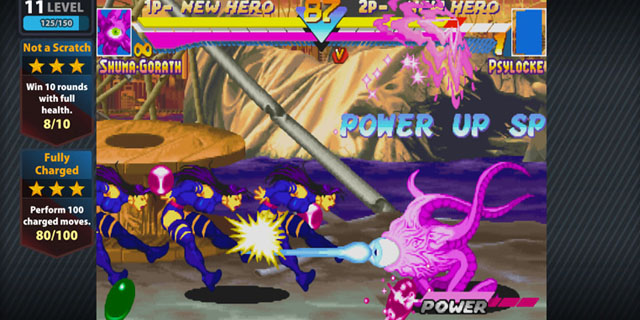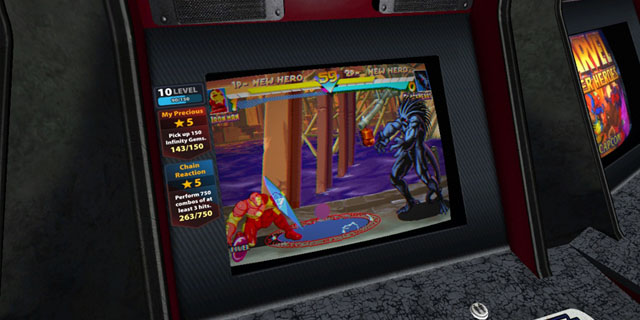
In spirit of Capcom re-releasing all its older games, Marvel vs. Capcom Origins makes an appearance on both the Xbox 360 and PlayStation 3. Along with the original Marvel vs. Capcom: Clash of Super Heroes, the collection includes Marvel Super Heroes. With two accurate arcade ports of the two games as well as online play, would it make the purchase worth it?
For two solid entries in the series, I’d say so.
Since this game technically has two games included, I’ll be splitting this review talking about each game. At their most absolute core, both games play very similarly to each other, with a few distinct differences.
Marvel Super Heroes was first released in the arcades back in 1995 and later ported to both the Sega Saturn and PlayStation two years later. This game featured several heroes and villains in the Marvel universe. What made this game unique was the use of gems that were featured in the Infinity Gauntlet storyline from the comics. The six gems (Power, Time, Space, Reality, Soul and Mind) each had their own unique abilities that each character could use to their advantage during battles. With certain gems, characters gain different abilities than what the game normally provides, such as Magneto activating a Space gem. Instead of it just normally increasing defense, it also gives him a force field that stops attacks in their tracks before they hit him.

Marvel vs. Capcom was the first entry in the series that’s still active today. First released in 1998, it was ported (perfectly) to the Dreamcast in 1999 and then (poorly) to the PlayStation in 2000 in North America. Some of the standout features for this game were the implementation of the Duo Team Attack, which summons your teammate to the screen for a short amount of time and gives an unlimited Super Bar to attack your opponent with. If used properly, the sheer force of two supers wailing on you could be devastating. While the use of summoning your own teammate as an assist isn’t present in this game, the game provides you with special assist character that can be used during the match. Characters like Ton Pooh from the Strider series, Lou from the Three Wonders collection or Michelle Heart from Legendary Wings would mark their first appearance outside from their original games.
Because this is an arcade port of the game, a feature missing from the Dreamcast version was the Cross Fever mode. Originally in Cross Fever, four characters would be able to battle at the same time simultaneously in a way similar to Scramble Battles in Street Fighter X Tekken today, or fight as a Tag Team.
While the nostalgia factor for these games is at an all time high, these were also two of the most broken and difficult games of the Capcom vs. series. The learning curve on each of these games were relatively difficult making it hard for newer players to pick up. Also, with the game making its debut in the arcade, the games were designed for players to drop multiple quarters into their local arcade machine cabinet, so even at its easiest difficulty, the game was still fairly tough.

What made matters worse were some characters were terribly imbalanced. While a good majority of the Marvel vs. Capcom cast could pack a wallop against each other, characters like Red Venom would have a high attack power and increased speed to make up for the lack of defense, and Gold War Machine sported the game’s ultimate defense that wouldn’t allow him to get knocked out of anything in return for being the slowest character in the game. Even Wolverine had ridiculously-powerful Heavy attacks that would wear down an opponent instantly, as well as build Super Meter quickly for the one controlling him.
However, the newest feature that everyone was looking forward to was the online mode. Seen previously in Street Fighter III: Third Strike Online, the GGPO system makes a triumphant return delivering a top notch online system. Unfortunately for the game, you can’t ban certain characters in quick or ranked matches. So be prepared to see a lot of Wolverines, Red Venoms and Gold War Machines online for the MvC side, and a lot of Anitas (a test character available in the game and ridiculously broken character due to her powerful special moves and height) on the Marvel Super Heroes side.
Also included in this game is a Vault mode that spans through both games. Here you can spend the points earned through various challenges done through gameplay to unlock artwork, music and even characters for permanent use in the game. The grind is tedious, but there’s a lot to unlock so it will keep you busy for a while.
While this game is difficult for beginners to get into, it wasn’t the intention for Capcom to release this for newer players. Unfortunately, the days of competitive play in local tournaments are long gone for this game, so the targeted audience would probably be people who played these games almost religiously in the past.
Marvel vs. Capcom Origins is still a blast to play, and I’ll continue to enjoy playing an occasional round or two against my friends. For those who have played some of the later Capcom vs. titles and want to see where it all started, or even players who have a forgotten connection with this game, this game provides an action-packed set of two of the most interesting entries in the series.
Pros: Solid online play, Vault Mode eases difficult conditions on character unlocks
Cons: Broken characters make gameplay unfair sometimes, difficult learning curve



















